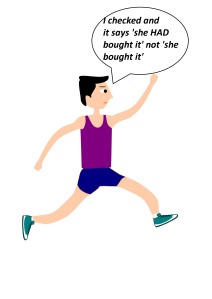Yesterday I was talking to a colleague about how challenging students are what helps us develop as teachers – you have to think on your feet and constantly think of ideas to keep them interested, awake and out of trouble. It made me think of one of my favorite activities in class – Running Dictation and how I had to adapt it to make it cheat-proof. More on that later, but now let’s see what Running Dictation is and how it can help avoid situations like this (true story and I didn’t know whether to laugh or cry at the time)

What is Running Dictation?
As you can probably guess from the name, it involves running and dictating.
- The teacher selects a text for dictation – depending on the level and the language you want your students to notice/practice. The text could be something you create yourself or a text from your textbook.
- Students are organized into groups (or pairs if you have a smaller class). One person in each group will be a writer (or secretary), other members of the group will become runners. Make sure students rotate their roles and take turns being writers and runners.
- Set the rules. Some important rules are that there can be only one runner at a time in a group and they cannot use any recording devices – i.e. no mobile phones or pens and papers or shout their sentences across the room.
- The teacher either keeps the copy of the text on them, or makes several copies and puts them up in class or outside of the class. The first option is the easiest in terms of control. The second option still lets you keep an eye on everything, but lets the students spread around. Putting the texts outside the class provides students with a bigger outlet for their energy – they will need to run further, but it’ll be harder to check that no cheating is going on (e.g. students aren’t taking sneaky photos of the text) and you need to make sure you aren’t disrupting other classes.
- The runners look at the text and try to memorize as much as they can before running back to their partner(s) and dictating their portion of the text. The runners can go back as many times as they need in order to complete the text, as long as they follow the rules.
- When a group says they are done, the teacher checks the text, and either accepts it or asks the group to work on it some more. Alternatively, the students get the original text and compare it with their version.
- Make sure there is a follow-up to the dictation – the follow-up can include focus on grammar, answering questions about the text, re-arranging the sentences or parts of the text (see below for ideas).
Why do Running Dictation?
The greatest thing about running dictation is its potential for shaking up your lesson – by getting your students moving and competing with each other, you get them excited about the topic at hand. Obviously, you wouldn’t want to do this every lesson or the activity will lose its appeal, but using it now and again will help you energize your class.
In addition, running dictation is a fun way to introduce/practice procedural and functional language – e.g. How do you spell that? Sorry, did you say we WANT or we WANTED? Also: capital letter, comma, new sentence, new paragraph etc.
Finally, and most importantly, this activity gets students to use a variety of skills and processes – speaking, listening reading, writing, negotiating of meaning, and engaging short-term memory. This also means the activity has the potential to engage learners with various leaning preferences. Now, how cool is that?
Grammar focus
You can use running dictation to help students notice certain language points. The text you s elect/create can contain a high occurrence of certain grammar items, e.g. articles or sentences with third person singular in Present Simple.
elect/create can contain a high occurrence of certain grammar items, e.g. articles or sentences with third person singular in Present Simple.
Let’s say you want to focus on the use of present continuous to describe annoying habits. The text would contain sentences like ‘My partner is always copying my homework’ and after the students have the complete text, you could ask them questions like ‘Are the sentences about what is happening now or what happens regularly? How do we know? How does the author feel about these things’?.
You could also get students to arrange the sentences in the correct order based on the grammar – e.g. putting together a story chain which uses the first conditional sentence (If I win the lottery, I`ll become a millionaire. If I become a millionaire…) in the correct order. After students complete the text, you can ask them to look at it and engage in some guided discovery.
Running dictation is also great for grammar revision, especially at lower levels where repeated exposure to target language and opportunities to reproduce the language are especially important.
Vocabulary focus
By virtue of being a dictation, this activity is helpful in focusing on spelling. You could also use running dictation to introduce things like idioms – by repeating the idioms several times in the course of the activity, the students focus on form, thus avoiding difficulties with remembering all the little function words such as articles and prepositions which tend to get left out as they aren’t as salient as nouns, adjectives and verbs.
Writing focus
For example, you might want your students to notice or revise connectors such as although, on the other hand etc. Prepare a short text where each sentence starts with a connector. Put the sentences up around the classroom in a random order. After the students find and write down all the sentences, they have to put them in the correct order using connectors as clues.
A fun running dictation could include a focus on text and internet abbreviations – things like B4 (before) and LOL. Students will have to work hard dictating these to each other (capital L…capital O…capital L). As a follow-up, you can then get them to decipher all the abbreviations and to re-write the text in ‘proper’ English.
Reading Focus 
Reading is my favorite way to use running dictation. I mean, how many times have announced a reading segment in class only to be met with groans of students who are bored in advance? Running dictation is great for
teaching students skimming and scanning in a fun and ‘learning by doing’ way. By limiting the students’ access to the text and introducing time pressure, you are removing the temptation to read every word and thus avoiding the situation where students get stuck in the text because they are focusing on unfamiliar words and failing to see the bigger picture.
You could also use reading dictation as a fun way to practice other reading skills. For example, after introducing students to the concept of inference, get them to answer a series of inferencing questions about a text.
No cheating!

This last paragraph might not apply if you are teaching motivated adult students who won’t dream of cheating. However, when I was teaching at a prep school of a private university, my 20+ class of rambunctious 18-year-olds loved nothing more than to outsmart the teacher. The story I will describe below developed over the course of several months and is a perfect example of the creativeness inspired by persistently difficult students.
Since we had such big classes, I usually put the text for the dictation outside of the classroom. The first rule they broke was that only one runner from a team can leave the classroom. It was hard for to remember which students belonged to each team so I found it hard to actually catch the cheaters. My new rule was that all runners must hold a cup to be able to leave the classroom. I positioned myself in the doorway and only let out the students who were holding paper cups. Soon, I found that a suspiciously large number of students was in possession of paper cups; moreover, some paper cups had dregs of tea and coffee. Clearly, my enterprising students collected every paper cup in the vicinity and were using them as their exit tickets. My solution? Customizing the paper cups by writing a team number on each cup. I was very pleased with myself until I spotted several cups bearing number 1 (some numbers were decidedly more crooked than mine). Finally, alternating between feeling angry at how much time I`m spending on this and laughing at the students persistence, I devised the final version of the anti-cheating cups: intricate design, involving multiple colors, squiggles and my signature on the bottom of the cup. It worked! Here is the approximation of that design since I no longer have the actual cups

Have you used running dictation before? Do you have ideas or questions? Comment below or contact me using the link at the top of the page.
